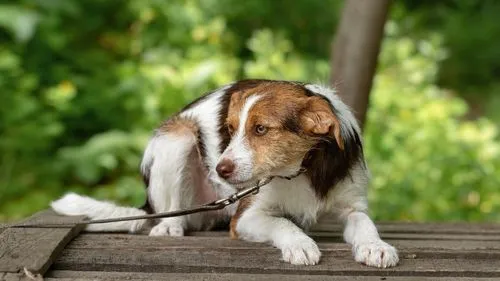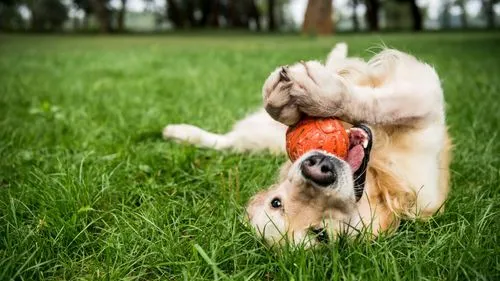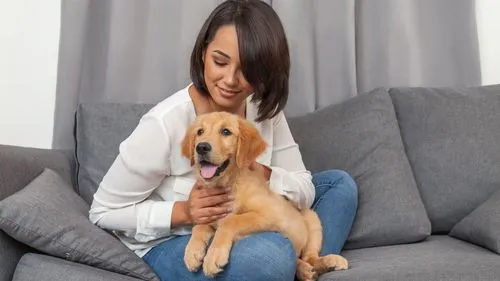How to prepare a dog for the arrival of a baby
February 18, 2025
Katka

The arrival of a baby in the household is a huge change not only for the parents but also for the dog. Changes in daily routines, new scents, sounds, and inevitably less attention can unsettle the dog. To prevent undesirable reactions, it is crucial to prepare the dog for this situation in advance. A properly trained dog can not only be a great partner for the child but also a positive asset for their development.
How to prepare the dog for the arrival of a baby?
1. Introduction to new stimuli
A dog perceives the world mainly through smell and hearing. Therefore, it is good to show him baby cosmetics, diapers, and other things that will be a common part of the household beforehand. If the dog has no experience with small children, you can gradually introduce him to their sounds – for example, using recordings of crying or laughing. It is important for him to associate these stimuli with something positive, like treats or petting.
2. Adjustment of daily routine
The arrival of a child will inevitably change the daily routine. If the dog will have different feeding, walking, or resting times, it is better to prepare him for these changes gradually. This will help minimize his stress and feelings of uncertainty. If you plan to change his habits (e.g., prohibiting access to certain rooms), start implementing these rules before the baby arrives.
“Clear rules help prevent misunderstandings.”
3. Setting rules
Clear rules in advance help prevent misunderstandings. If the dog is not allowed in the baby's room or on the couch, it is good to teach him this before the baby arrives. It is also helpful to teach the dog commands like "place," "wait," or "go away," which will help better manage his movement around the house.
The first contact between the dog and the newborn
The first meeting of the dog with the newborn is a crucial moment that will influence their future relationship. For it to happen safely and smoothly, it needs to be properly planned and managed.
Preparation for the first meeting
First and foremost, ensure that the dog is calm. It is recommended to tire the dog out with a walk or play before bringing the baby home, so he is not overly excited.
Before you bring the baby home, let the dog sniff the clothing or blanket the baby was wrapped in, to gradually get used to the new scent.
The course of the first meeting
Let the dog greet the other family members as usual. Then introduce him to the baby in a calm area without distractions. It is best to let the dog sniff the baby from a safe distance and gradually bring him closer based on his reactions. A few important tips:
Keep the dog under control: Use a leash or collar if you are unsure of his reaction. It is important for the dog to have the opportunity to sniff the baby but also to not be too close.
Keep the baby in a safe position: Hold the baby in your arms or let them lie in a crib. Do not allow the dog to be too close to the newborn's face.
Watch the dog's reactions: Observe the dog's body language. If he is relaxed, wagging his tail calmly, or behaving curiously, that is a good sign. If the dog shows signs of stress (stiff body, avoiding eye contact, yawning, licking his nose, growling), interrupt the meeting and give him more time to adapt.
The dog should receive praise and a treat for calm and obedient behavior in the presence of the baby. This way, he will associate the new situation with a positive experience.
What to do after the first meeting?
Initially, let the dog be with the baby only for a short time, gradually increasing their contact and monitoring their reactions. Continue to give attention to the dog, play with him, and provide regular exercise to prevent him from feeling neglected.
Even if the dog responds calmly, the baby and the dog should always be supervised by an adult.

When to be alert and seek a professional?
Owners should pay attention to any changes in the dog's behavior that could signal stress or discomfort related to the arrival of the baby. Situations when it is appropriate to consider consulting a professional include:
Aggression towards the baby: Any signs of growling, barking, threatening posture, or attempts to bite are warning signals that cannot be ignored.
Chronic stress: If the dog shows prolonged signs of stress, such as loss of appetite, destructive behavior (e.g., destroying furniture), excessive barking, or restlessness.
Significant change in behavior: If the dog lost interest in his usual activities after the arrival of the baby, is distancing himself from the family, or conversely shows excessive need for attention.
Anxious behavior: Constant whining, hiding, excessive licking, frequent yawning, or any form of self-harm may signal a more serious problem.
Avoiding being near the baby: If the dog intentionally seeks isolation, runs away from the baby, or avoids contact.
Reaction to the baby's touch: A dog that previously responded well to physical contact but now flinches, withdraws, or shows tension when touched by the baby.
Resource guarding: If the dog starts to guard food, toys, or bed from the baby, it could lead to dangerous situations.
Attention! If any of these problems arise, it is advisable to seek help from a professional, such as a veterinary behaviorist or an experienced trainer, who can help identify the cause and propose suitable solutions for the safe coexistence of the dog and the child.
Safety measures and health risks
1. Do not leave the dog and baby alone
Even though the dog is part of the family, it is important to prioritize the baby's safety. Even the calmest dog can react unexpectedly if he feels threatened or confused.
2. Hygiene is key
The dog should be regularly vaccinated and dewormed. The baby should not come into direct contact with his saliva or food bowl. It is also good to keep the dog's bed clean and regularly disinfect the spaces where the dog sleeps and eats.
3. Beware of disease transmission
Dogs can transmit parasites, bacteria, and viruses. The most common include toxocariasis (a parasitic disease), salmonellosis, or staphylococcal infections. Regular veterinary check-ups and hygiene are therefore essential.
4. Dog's reaction to the baby's cry
Some dogs may react anxiously or irritably to the baby's cry. It is recommended to gradually expose them to baby sounds using recordings. If the dog shows stress signals (whining, restlessness, hiding), it is good to calm him down and reward him for a calm reaction.

How to build a positive relationship between the dog and the baby?
1. Involve the dog in family life
To prevent the dog from feeling jealousy or anxiety, it is important to actively involve him in life with the baby. The baby did not replace the dog, but rather complemented the family. Even with the arrival of a baby, it is necessary to devote enough time to the dog. Short games or walks are sufficient so that he does not feel pushed aside.
“The baby did not replace the dog but rather complemented the family.”
Walks with the stroller or calm moments in the presence of the baby will help create a positive bond.
2. Training and rewards
Consistency in training and positive motivation are key to harmonious coexistence. Useful commands include "sit," "stay," "down," and "leave it." If the dog responds well to rewards, it will be easier to guide him towards safe behavior in the presence of the baby.
3. How to manage potential conflicts
If the dog reacts negatively, such as by growling or backing away from the baby, it is essential to assess the situation correctly. Never punish the dog for signs of discomfort – instead, allow him a safe retreat and work on his socialization. If problems persist, consider consulting a professional.

Frequently asked questions
1. How to prepare the dog for the arrival of the newborn?
Before the baby arrives, it is important to introduce the dog to new scents and sounds, such as using baby cosmetics or recordings of baby crying. Gradually adjust the dog's daily routine to align with future changes and set clear rules, such as prohibiting access to certain rooms.
2. How to safely introduce the dog to the newborn?
The first meeting should take place in a calm and controlled atmosphere. Let the dog sniff the baby from a safe distance and watch his reactions. Never leave the dog and the baby alone, and always supervise their interactions.
3. How to ensure hygiene during the coexistence of the dog and the newborn?
Maintain cleanliness in the household through regular cleaning and disinfecting spaces where the dog moves. The dog should be regularly vaccinated and dewormed. The baby should not come into direct contact with the dog's saliva or food bowl.
4. What to do if the dog is jealous of the newborn?
Involve the dog in family activities related to the baby, give him enough attention and reward him for calm behavior in the presence of the newborn. If jealousy persists, consider consulting an animal behaviorist.
5. What are the warning signs of stress in the dog after the arrival of the newborn?
Signs of stress include excessive licking, yawning, trembling, growling, attempting to escape, or destructive behavior. If you notice these signs, it is important to address the situation and consider seeking professional help.
6. How to teach the dog to respect the newborn's space?
Train the dog on commands like "place," "wait," or "leave it." Reward him for following these instructions and gradually teach him which areas are off-limits to him.
7. Is it safe to have a dog and a newborn in the same household?
Yes, with proper safety precautions, hygiene, and consistent supervision, the coexistence of a dog and a newborn can proceed harmoniously and safely.
8. How to address aggressive behavior of the dog towards the newborn?
If the dog shows aggression, it is crucial to immediately separate the dog from the baby and seek help from an animal behaviorist. Never underestimate such behavior.
9. How to prevent the dog from accessing the baby's toys?
Keep the baby's toys out of the dog's reach and teach him to differentiate between his and the baby's belongings. Provide the dog with his own toys and reward him for using them.
10. How to support a positive relationship between the dog and the newborn?
Supervise their moments together, reward the dog for calm and friendly behavior, and gradually increase the duration and frequency of their interactions.
Conclusion
The coexistence of a dog and a newborn can be a beautiful and beneficial experience if the transition is managed well. By following safety measures, maintaining proper hygiene, and providing the dog with proper socialization, a harmonious relationship can be created between the child and their four-legged friend that can last a lifetime. The key to success is respect, patience, and gradual adaptation to new living conditions.
Continue reading...
Show all articlesCopyright & trademark notices
Apple, the Apple logo, and iPhone are trademarks of Apple Inc., registered in the U.S. and other countries and regions. App Store is a service mark of Apple Inc. Mac App Store is a service mark of Apple Inc. Google Play and the Google Play logo are trademarks of Google LLC. Windows® and the Windows logo are either registered trademarks or trademarks of Microsoft Corporation in the United States and/or other countries. Linux® is the registered trademark of Linus Torvalds in the U.S. and other countries.


